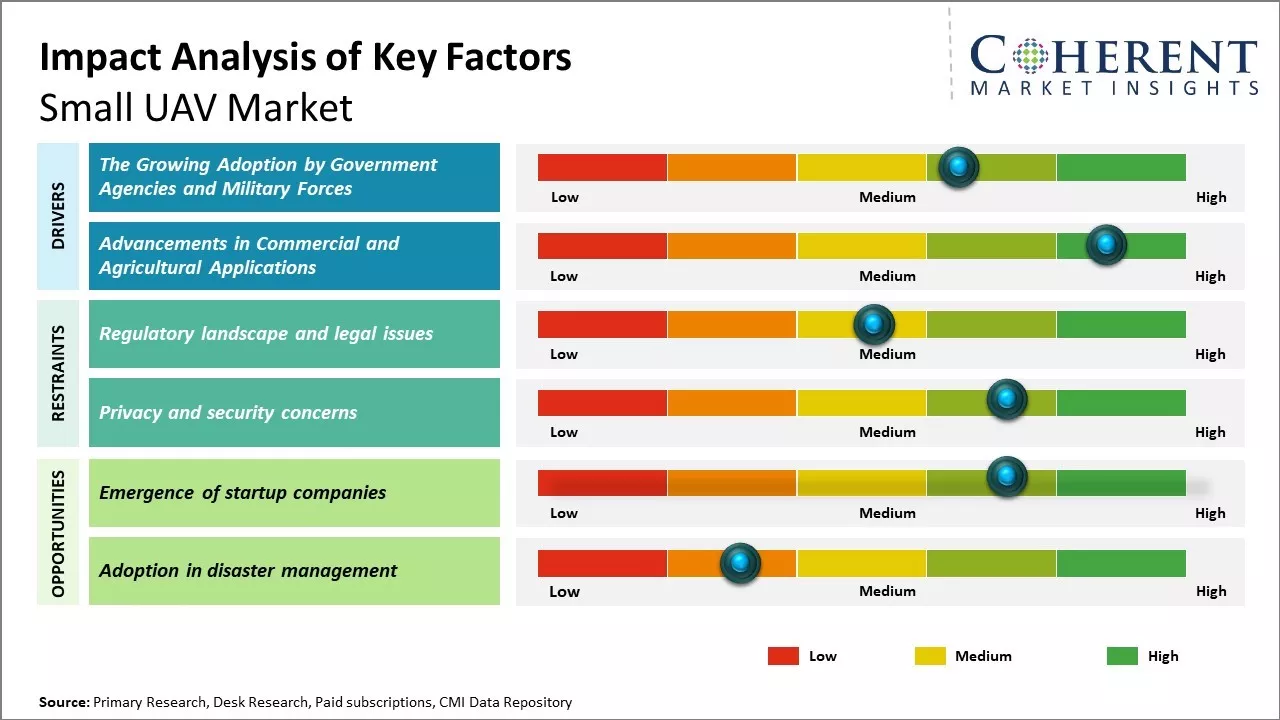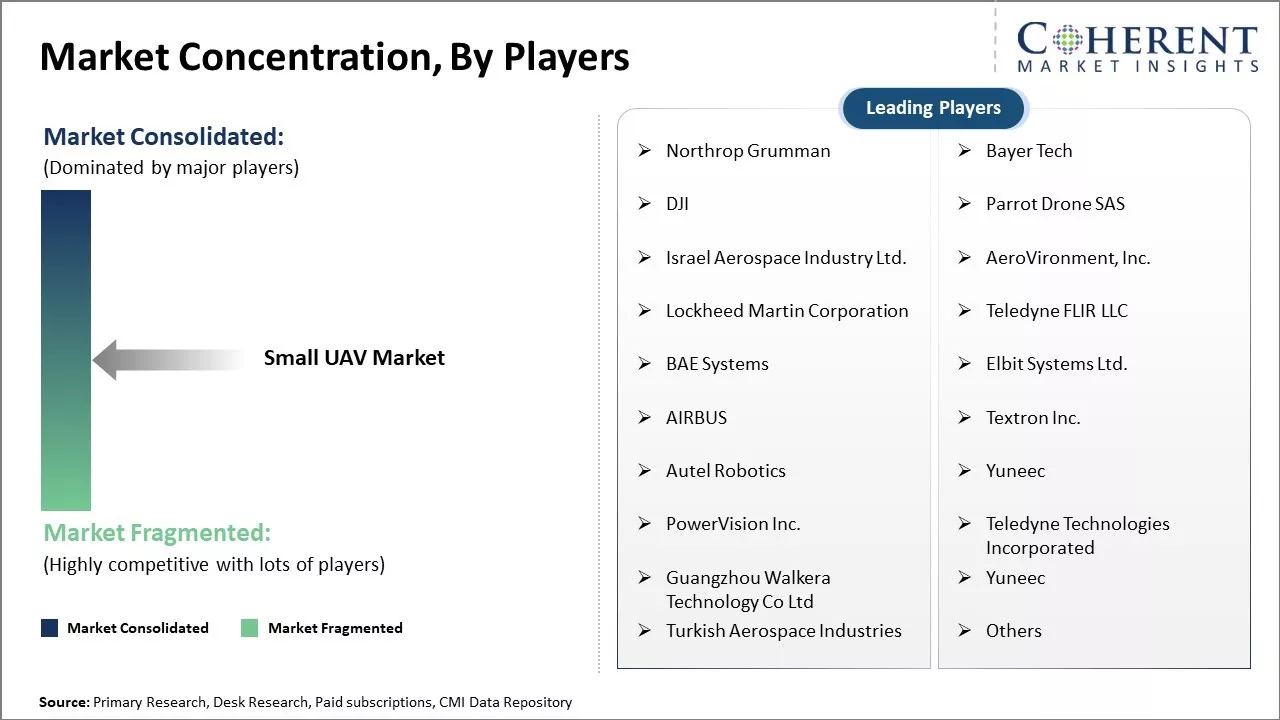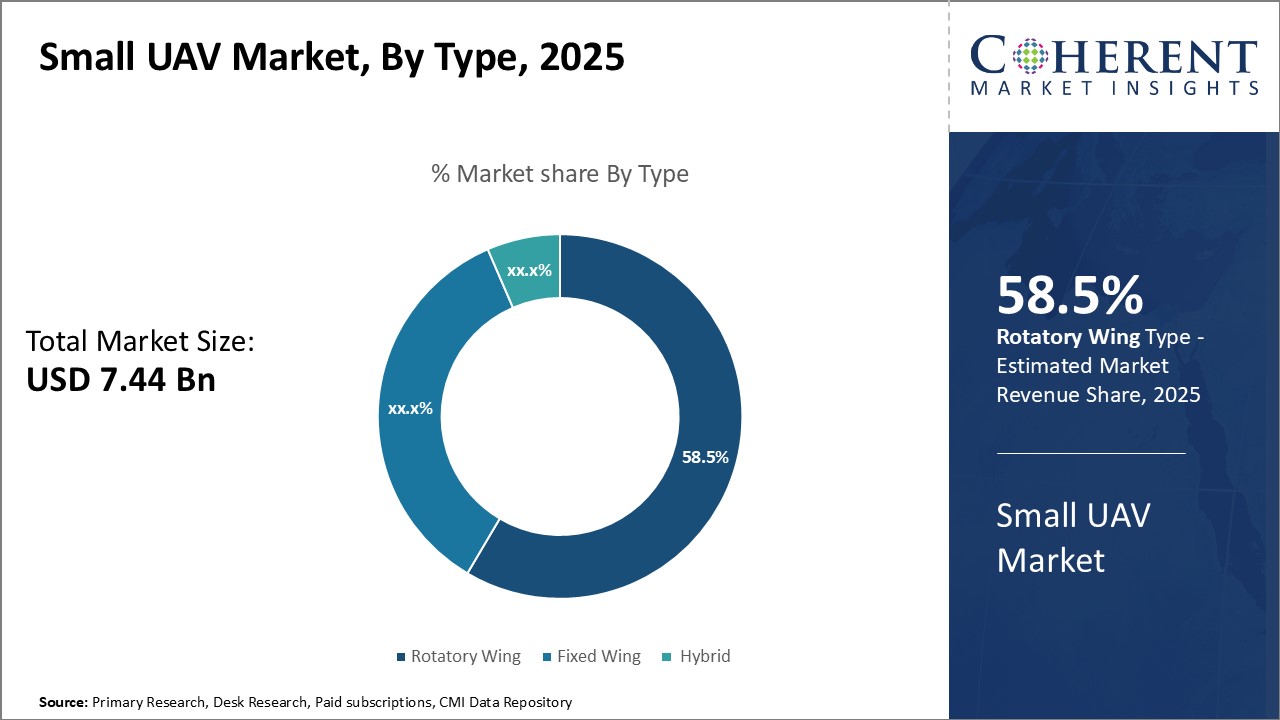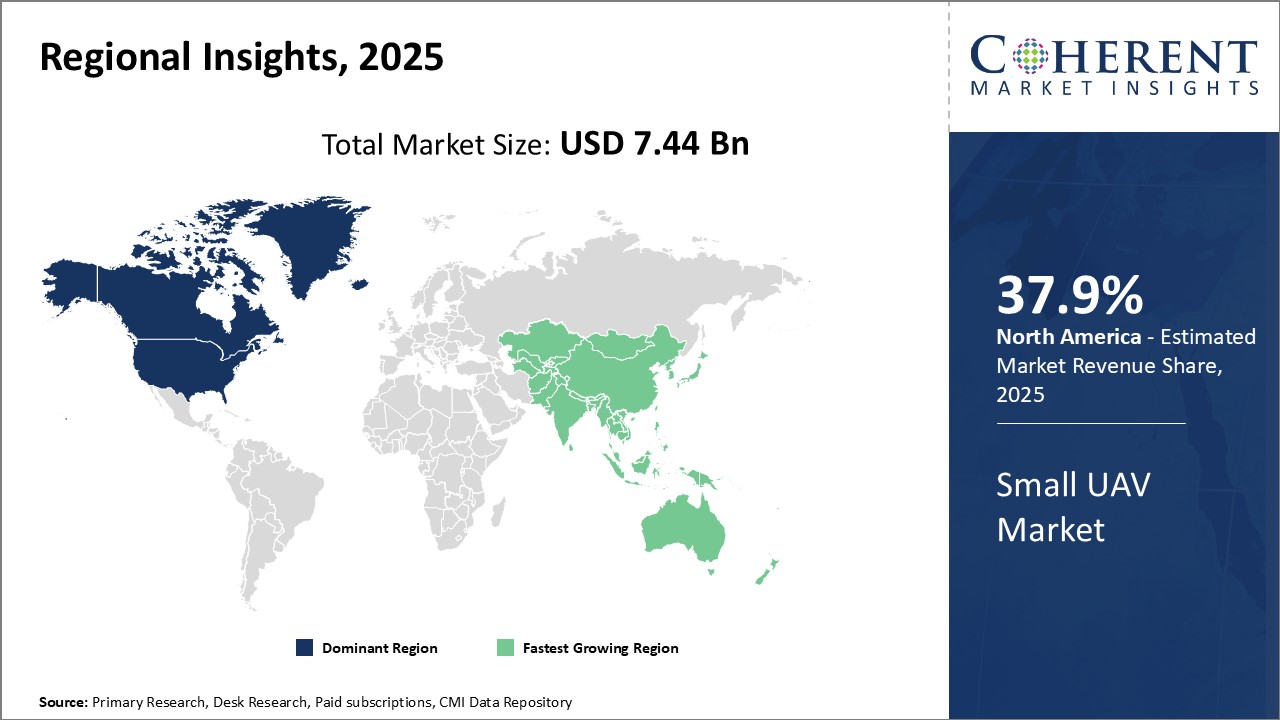Small UAV Market Size and Trends
The small UAV market is estimated to be valued at US$ 7.44 billion in 2025 and is expected to reach US$ 16.06 billion by 2032, growing at a compound annual growth rate (CAGR) of 11.6% from 2025 to 2032.

Discover market dynamics shaping the industry: Download Free Sample
The small UAV market is witnessing significant growth driven by factors such as the increasing adoption of these drones for commercial applications across industries such as agriculture, insurance, security, and surveillance. The surging popularity of mini drones for recreational purposes among households is also supporting the market growth. Additionally, technological innovations leading to the development of advanced small drones with features such as high resolution cameras, extended battery life, and autonomous operations are expanding the scope of applications. However, regulatory constraints around drone usage in certain countries may hinder the market growth to some extent. Continued regulatory easing is expected to further open up new use cases and catalyze small Unmanned Aerial Vehicle (UAV) adoption going forward.
Small UAV Market Drivers:
The Growing Adoption by Government Agencies and Military Forces
The use of small UAVs for both military and civilian applications by government agencies is growing rapidly around the world. Many countries are investing heavily in developing drone technologies to gain strategic advantages and enhance surveillance capabilities. Law enforcement and border security agencies have also recognized the potential of drones to more effectively monitor areas, track criminal activity and suspects. Their low operational costs compared to manned aircraft and ability to reach remote locations is making them especially appealing for military training exercises and homeland security missions. The Federal Aviation Administration (FAA) predicts governmental agencies will account for over half of all drone registrations in the U.S. in the coming years.
The expanding role of drones for disaster management and emergency response operations is another key factor driving their adoption. Several firefighting and emergency medical services departments have already started deploying small drones equipped with cameras and sensors to assist in Search and Rescue missions amidst natural disasters like floods, earthquakes, or wildfires. They allow emergency crews to rapidly scan vast affected areas from the sky and locate people trapped under debris or stranded residents in need of aid. Drones are also being used to survey infrastructure damage and disruption caused by disasters to facilitate restoration and relief work. This is likely to further increase their procurement and integration within governmental organizations worldwide looking to bolster emergency preparedness and response capabilities.
Market Concentration and Competitive Landscape

Get actionable strategies to beat competition: Download Free Sample
Advancements in Commercial and Agricultural ApplicationsRapid technological enhancements have enabled the design of small drones that are more stable, precise and able to carry heavier payloads for commercial tasks. This has allowed the utilization of drones in a growing variety of industries like construction, energy, telecommunications, insurance, and real estate. Construction companies are deploying drones fitted with advanced sensors to monitor progress on projects, inspect buildings and infrastructure for defects, and support site surveying activities more efficiently. In agriculture, drones are helping farmers closely assess crop health, identify areas requiring more water or fertilizer and monitor livestock. Some drones can also automatically spray fertilizers and pesticides with precision targeted at specific problem zones in fields, reducing chemical waste and labor costs.
Another major driver is the rising adoption of drones for delivery services by online retailers and food chains. Several pilot projects testing medical and food deliveries via drones to remote communities have already shown promising results. Major e-commerce firms are investing in developing autonomous drone fleets and increasing payload capacity for long-range deliveries directly to consumers’ doorsteps.

To learn more about this report, Download Free Sample
Small UAV Market Challenges:The small UAV market faces several challenges in the coming years. Strict regulations around flying drones commercially and privacy present large roadblocks to growth. Earning certification to fly drones for business purposes requires jumping through many regulatory hoops. Additionally, concerns over data security and privacy issues may slow mainstream adoption. Small UAVs also have limitations related to battery life and payload capacity that manufacturers are working to improve. Weather conditions can impact flight time and overall operations. Maintaining quality control on small intricate components adds complexity to mass production.
Small UAV Market Opportunities:
However, the small UAV market also presents many promising opportunities. Commercial industries are increasingly integrating drones into their daily operations for tasks like inspection, photography, and delivery. Rapid technological advancements in areas like artificial intelligence, computational photography, and battery capacity will help address current limitations.

Discover high revenue pocket segments and roadmap to it: Download Free Sample
Insights By Type- Agility and Vertical Take-off Ability Drive the Rotary Wing Segment GrowthThe rotary wing segment contributes the highest share of 58.5% in 2025 of the small UAV market due to its agility and ability to take-off and land vertically. Rotary wing UAVs are highly maneuverable since they can move in any direction by changing the speed of individual rotor blades. This allows them to hover stationary in the air, move sideways and backwards, effectively navigating tight spaces. Their vertical take-off and landing capability provides more flexibility compared to fixed wing UAVs that require a runway for take-offs and landings. This trait makes rotary wing UAVs well-suited for situations requiring inspection of structures from multiple angles or delivery of payloads to hard to reach locations.
Another factor boosting the rotary wing segment is its practicality for civilian, commercial and emergency response applications. It can be deployed rapidly for monitoring crops, infrastructure, deliveries and search & rescue operations. Civilian users prefer rotary wing UAVs as they do not require extensive pilot training and their controls are intuitive for novice operators. This has increased their adoption rate among amateur photographers, filmmakers and inspectors. Their vertical launch ability also aids applications like scanning buildings from multiple floors or delivering medical supplies internally. The simplicity of operations with rotary wing UAVs attracts more commercial clients and government agencies on a budget.
The military remains a key customer for technologically advanced rotary wing UAVs capable of intelligence, surveillance and reconnaissance missions. Models with enhanced endurance, sensors, and payload capacities fulfill tactical intelligence needs. Miniature armed copters are being tested for specialized missions requiring vertical firing capability. Overall, factors like agility, easy operations, and versatility continue stimulating demand in the rotary wing segment.
Insights By, Take-Off Weight- Surveillance and Reconnaissance Drive the Demand for the 5 to 25kg UAV Category
The 5 to 25kg category contributes the highest share of 45.5% in 2025 due to the range catering to surveillance and reconnaissance applications. UAVs weighing between 5 to 25kg have enough lift capacity for specialized sensor payloads along with adequate flight duration from their larger size.
Military and government agencies extensively use models in this category for battlefield and border surveillance. They carry sophisticated daytime and thermal cameras, as well as signals interception packages for intelligence gathering. The payload capacity allows these UAVs to transmit real-time imagery and data over long distances. Their endurance enables continuous monitoring of wide areas and targets for extended surveillance missions.
Commercial users also rely on the 5-25kg category for infrastructure, agricultural and disaster management applications. Utility firms employ them to inspect energy grids and pipelines periodically. Farmers deploy them for analyzing crop health, mapping fields, and monitoring livestock. Emergency services use their surveillance capabilities during search and rescue or assessing damage post-disasters.
Law enforcement agencies are increasingly adopting them for criminal investigations, tracking suspects, monitoring demonstrations, and disaster control situations. Overall, the dual-use surveillance capabilities and optimized size of UAVs in the 5-25kg category has accelerated their market uptake.
Insights By, Application- Military Accounts for the Largest Share due to Strategic Missions
The military segment contributes the highest share of 53.5% in 2025 of the small UAV market owing to their critical roles in modern warfare. UAVs provide situational awareness during combat missions while minimizing troop risk. They are extensively used for Intelligence, Surveillance and Reconnaissance missions along borders and within enemy territories. Mini UAVs help gather real-time tactical intelligence on troop movements and hostile activities.
Their low-altitude, long-endurance capability aids strategic missions like continuous electronic monitoring, airspace situational awareness, targeting, battle damage assessment, and signal interception. Modular payload bays allow seamless integration of Electro-Optical/Infra-Red (EO/IR) sensors, data links, and munitions based on mission needs. Armed Small UAVs are even transforming tactics with combat air support and targeted strikes behind enemy lines.
Advanced militaries rely on their coordination with other assets like satellites, cruise missiles and manned aircraft for comprehensive battlespace awareness. Mini UAV "swarms" are being tested to overwhelm enemy defenses. Overall, the strategic and operational values of Small UAVs for modern military missions ensure the armed forces remain their largest customer segment. Their specialized features and tactical applications continue fueling robust spending on military small UAV systems globally.
Regional Insights

Need a Different Region or Segment? Download Free Sample
North America has been the dominant region in the global small UAV market for years. With heavy investment from both the public and private sector, the US in particular has emerged as a leader in small UAV technology innovation. Several top UAV manufacturers and technology companies are headquartered in the region including DJI, 3D Robotics and drone delivery startup, Flirtey. This presence of major industry players has created a robust manufacturing and design ecosystem for small UAV development. Additionally, the defense and homeland security sectors have also driven adoption with requirements for ISR and border surveillance applications. The strong funding support from Department of Defense and NASA has helped the regional industry in achieving higher capability and efficiency benchmarks compared to others globally.
However, the dominance of North America is facing stiff competition from Asia Pacific in recent years, mainly driven by China. The Chinese government's "Made in China 2025" policy has prioritized UAV technology as one of the focus areas. This policy support along with the availability of low-cost skilled workforce has fueled explosive growth in domestic UAV manufacturers. Companies such as DJI, XAG, and Ehang have made China as the largest exporter of civilian and commercial UAVs worldwide. Moreover, the massive civilian use of drones for applications like aerial photography and infrastructure inspection within China has further encouraged technology development. This first-mover advantage and experience is now helping Chinese firms to expand exports and market share aggressively across Asia Pacific and Europe. With its continued government backing and expanding international presence of Chinese manufacturers, Asia Pacific is emerging as the fastest growing regional market for small UAVs globally.
Market Report Scope
Small UAV Market Report Coverage
| Report Coverage | Details | ||
|---|---|---|---|
| Base Year: | 2024 | Market Size in 2025: | USD 7.44 Bn |
| Historical Data for: | 2020 To 2024 | Forecast Period: | 2025 To 2032 |
| Forecast Period 2025 to 2032 CAGR: | 11.6% | 2032 Value Projection: | USD 16.06 Bn |
| Geographies covered: |
|
||
| Segments covered: |
|
||
| Companies covered: |
Northrop Grumman, Bayer Tech, DJI, Parrot Drone SAS, Israel Aerospace Industry Ltd., AeroVironment, Inc., Lockheed Martin Corporation, Teledyne FLIR LLC, BAE Systems, Elbit Systems Ltd., AIRBUS, Textron Inc., Autel Robotics, Yuneec, PowerVision Inc., Teledyne Technologies Incorporated , Guangzhou Walkera Technology Co Ltd, Yuneec , Turkish Aerospace Industries, and Others |
||
| Growth Drivers: |
|
||
| Restraints & Challenges: |
|
||
Uncover macros and micros vetted on 75+ parameters: Get instant access to report
Small UAV Industry News
- In April 2023, SZ DJI Technology Co., Ltd. is a prominent Chinese technology company specializing in unmanned aerial vehicles (UAVs) launched Mavic 3 Pro, a top-tier drone with three cameras. It boasts an extended flight time of up to 43 minutes, advanced obstacle detection, and can transmit high-definition video up to 15km away. This drone empowers creators to explore new levels of imagination.
- In March 2023, the Federal Aviation Administration (FAA) approved the Pearland Police Department in Texas to utilize drones as first responders, allowing them to operate Beyond Visual Line of Sight (BVLOS) without visual observers. This move came as part of the department's initiative, the Drone as First Responder (DFR) program, aimed at improving their response to emergency situations.
- In February 2023, a scientific team flew the Autel EVO Lite+ drone into the active main crater of Costa Rica's Irazú volcano. Equipped with a 6K camera, the drone assisted in documenting various aspects of the volcano, such as lake water levels, mineralization or crystallization areas, and potential vents releasing volcanic emissions.
- January 2023 Autel Robotics is a well-known company that specializes in the design, development, and manufacturing of unmanned aerial vehicles (UAVs) launched EVO Max 4T, a compact drone tailored for first responders. Featuring a thermal zoom camera and range finder, this drone boasts a 640x512 thermal camera, a 50MP wide camera, and a 48MP zoom camera capable of 10x optical and 160x digital zoom. Additionally, it holds an IP43 rating, allowing it to operate in light rain and snow conditions.
- In November 2022, the Direction Générale de l’Armement (DGA), the French Government's defense procurement and technology agency, received 400 ANAFI USA micro-drones. These micro-drone systems are designed to fulfill the operational needs of the three armies, including conventional and Special Forces units. The DGA specified that 12% of the systems will go to the air and space force, 28% to the French navy, and 60% to the army.
*Definition: The small UAV market consists of unmanned aerial vehicles that are designed for civilian and commercial applications. These lightweight, compact drones typically have a maximum take-off weight of less than 55 lbs and are used for applications such as photography, videography, inspection, survey, and mapping. They offer an affordable alternative to manned aircraft and helicopters for capturing aerial images and performing tasks that can be dangerous, dull, or dirty. The small UAV market is experiencing rapid growth as technological advancements improve functionality while reducing costs.
Market Segmentation
- Type Insights (Revenue, US$ BN, 2020 - 2032)
- Fixed Wing
- Rotary Wing
- Hybrid
- Take-off Weight Insights (Revenue, US$ BN, 2020 - 2032)
- Less than 5kg
- 5 to 25kg
- Above 25 to 150kg
- Application Insights (Revenue, US$ BN, 2020 - 2032)
- Military
- Commercial
- Government & Law
- Regional Insights (Revenue, US$ BN, 2020 - 2032)
- North America
- U.S.
- Canada
- Latin America
- Brazil
- Argentina
- Mexico
- Rest of Latin America
- Europe
- Germany
- U.K.
- Spain
- France
- Italy
- Russia
- Rest of Europe
- Asia Pacific
- China
- India
- Japan
- Australia
- South Korea
- ASEAN
- Rest of Asia Pacific
- Middle East & Africa
- GCC Countries
- South Africa
- Rest of Middle East & Africa
- North America
- Key Players Insights
- Northrop Grumman
- Bayer Tech
- DJI
- Parrot Drone SAS
- Israel Aerospace Industry Ltd.
- AeroVironment, Inc.
- Lockheed Martin Corporation
- Teledyne FLIR LLC
- BAE Systems
- Elbit Systems Ltd.
- AIRBUS
- Textron Inc.
- Autel Robotics
- Yuneec
- PowerVision Inc.
- Teledyne Technologies Incorporated
- Guangzhou Walkera Technology Co Ltd
- Yuneec
- Turkish Aerospace Industries
Share
Share
About Author
Suraj Bhanudas Jagtap is a seasoned Senior Management Consultant with over 7 years of experience. He has served Fortune 500 companies and startups, helping clients with cross broader expansion and market entry access strategies. He has played significant role in offering strategic viewpoints and actionable insights for various client’s projects including demand analysis, and competitive analysis, identifying right channel partner among others.
Missing comfort of reading report in your local language? Find your preferred language :
Transform your Strategy with Exclusive Trending Reports :
Frequently Asked Questions
EXISTING CLIENTELE
Joining thousands of companies around the world committed to making the Excellent Business Solutions.
View All Our Clients
